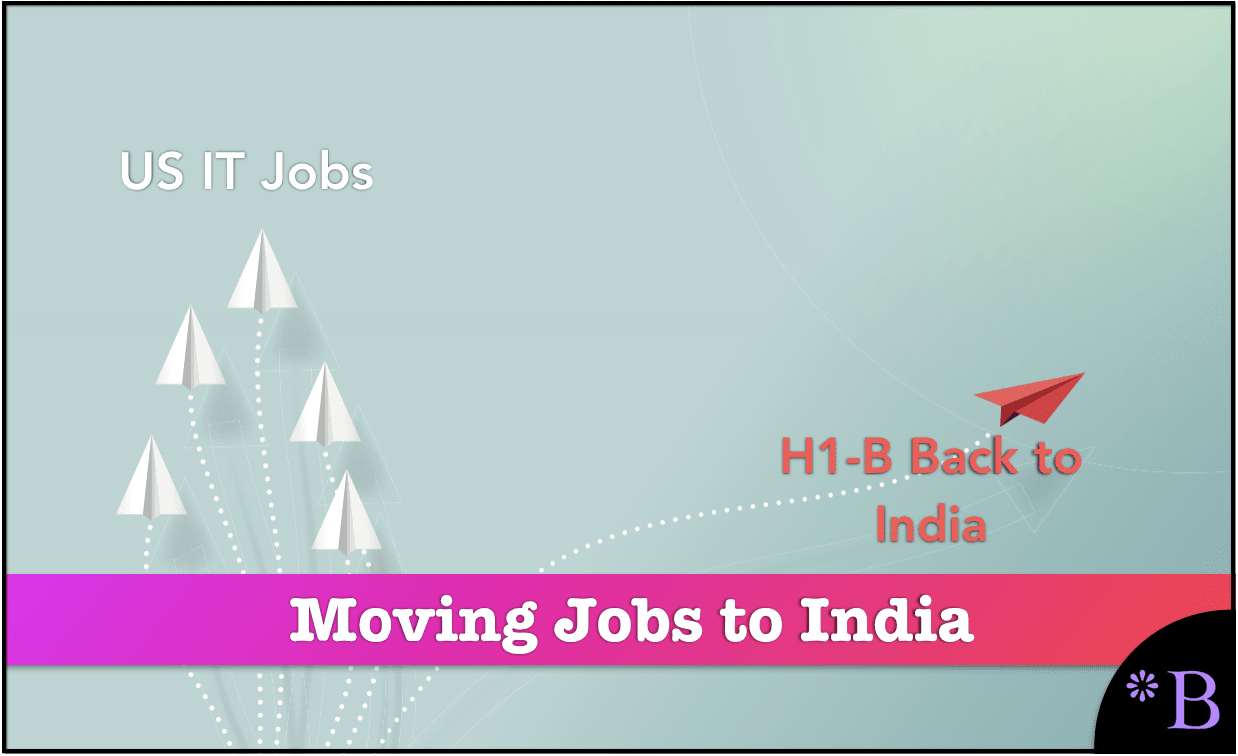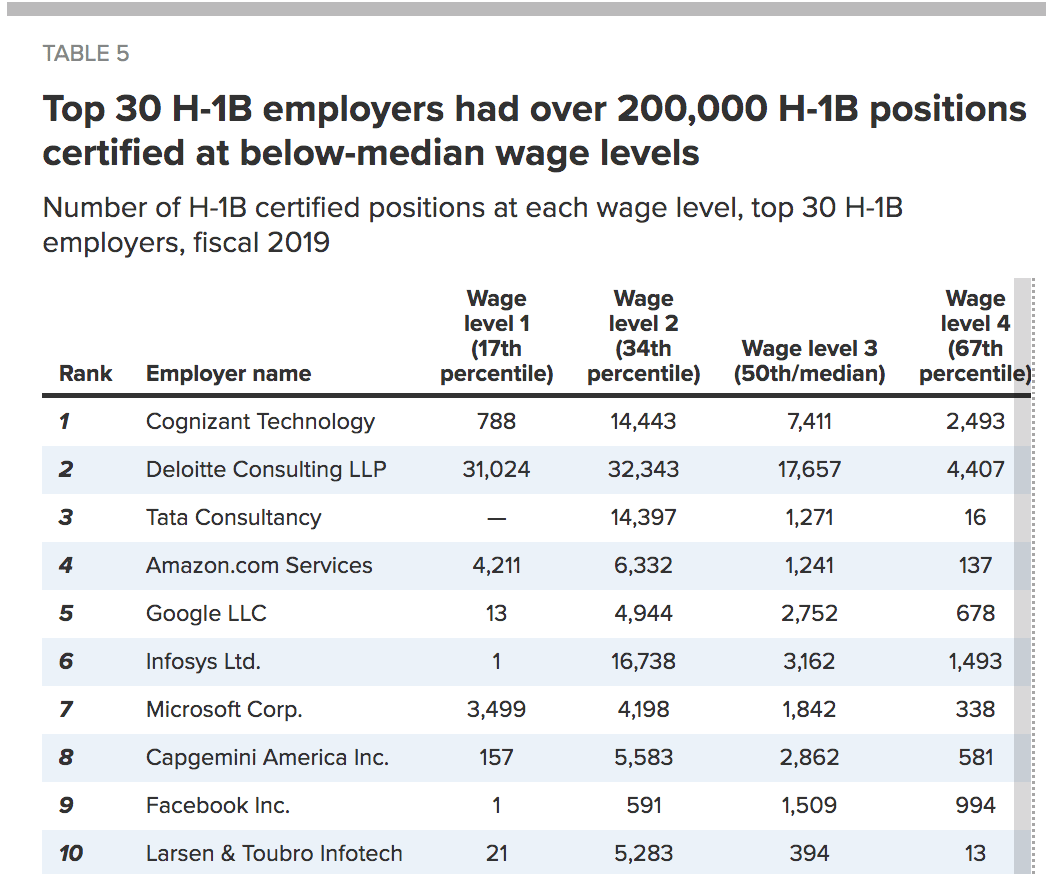How IT Outsourcing Firms Reduce Wages by Moving the H1-B Indian Worker Back to India
Executive Summary
- IT Outsourcing firms often bring H1-B workers over to the US temporarily to be trained.
- They then send the worker back to India and reduce their wages to Indian levels.

Introduction
The H1-B visa is often presented as only bringing Indians over to the US to work. However, the H1-B visa is critical in allowing IT outsourcing firms to perform knowledge transfer from US IT workers to Indian workers to occur in the US, until the Indian worker can be sent back to India.
How to Displace US Domestic IT Workers by Moving the H1-B Indian Worker Back to India
Once the worker is trained and learns the job in the US, some of them are sent back to India to continue their work. This means that the outsourcing firm can pay even less. So the company continues to charge the same rate but then pays far less to the Indian employee.
A study published by Daniel Costa and Ron Hira in the Economic Policy Institute titled H-1B visas, and prevailing wage levels found the following.
In some cases the work is later moved abroad to the H-1B worker’s country of origin once the worker has become proficient enough in the job to perform it remotely from abroad. – Daniel Costa and Ron Hira
As we cover in the article How Infosys Violated B-1 Visa Law and Charged Clients a 98.6% Margin, some companies skip the step of applying for an H1-B visa and have brought over Indians on a B-1 visa, which does not allow the individual to work. They then charged them at US rates while they were in the US. This is how Infosys was able to achieve close to a 100% margin.
How Many of the Top H1-B Employers Are Outsourcing Firms?
The IT outsourcing business is not a minor area of the H1-B program.
Half of the top 30 H-1B employers use an outsourcing business model.(emphasis added)
Fifteen of the companies listed in the top 30 H-1B employers have a business model based on outsourcing jobs; these companies place their H-1B hires at third-party client sites. These companies rely on the H-1B program to build and expand their business, which sometimes includes sending U.S. jobs overseas.– Daniel Costa and Ron Hira
This means that the 1/2 of the largest H1-B employers often use their H1-Bs to displace US workers. In other cases, they are placed on consulting projects.
All of the major IT consulting firms now have substantial outsourcing businesses, which means that increasingly, the IT consulting business and outsourcing business go together. This is true of even the “top end” IT firms like Capgemini, which we cover in the article How US IT Consulting Companies Acquire Indian IT Outsourcing Companies.

Many of the firms that receive the most H1-B visas perform outsourcing, and it means that they are paying significantly less for their workers. Each of these companies can be considered managers of large H1-B workforces. When they meet with their customers and prospects, they never bring up the fact that so many of their employees are H1-B visa holders. I worked for a consulting firm as a contractor that had no US domestic workers as consultants. They were all Indian, all on H1-B, all being paid below-market rates.
None of those employees were chosen because they were exceptionally skilled, but because they provided the highest possible margins. The H1-B employees would put anything on their resume that was asked.

This table shows exactly how many H1-B visa holders fell into which wage level category.
The Double Lie About Equivalent Wages for H1-B
First, as we cover in the article What the H1-B Program is Really Used For Versus its Advertised Use, the vast majority of H1-B visa holders are paid well below market wages (which does not include the additional negative impact of having more supply of workers versus the same demand. However, a second lie about the H1-B program is that a substantial portion of the H1-B visa holders is sent back to India.
If we disregard the major is of the export of skills for a moment, it means that as soon as the Indian H1-B worker arrives in India, they are switched back to the Indian wage level. Now the Indian is doing the work in India, but with the knowledge and skills transferred from the US worker — who is now out of work! This allows the outsourcing firm not only to increase their margin but because the wages in India are so low compared to the US, it means that this creates a massive financial incentive to outsource as much work as possible.
Furthermore, the management of how many of the outsourced labor force for any particular US customer is either in India or in the US is controllable by the outsourcing firm.
Rotating Indians Through the US Customer and then Back to India
By rotating Indian employees through the H1-B visa program, the firm can get exposure to the customer and knowledge transfer. This means that there may be several on-site H1-B visa holders, or Indians previously on H1-B but who now have matriculated to Green Card status, with 1/2 or 3/4rs of the outsource team back in India. There are also many cases of impersonation where Indians are using the H1-B visa of another worker, which increases the rapidity of the rotation.
In each case, Indians are only paid the US wage for their time in the US. Furthermore, there are many examples of even this rule being violated, as we cover in the article How Infosys Violated B-1 Visa Law and Charged Clients a 98.6% Margin.
With a blended rate (which is the average of the Indians in India and the Indians in the US as part of the outsourcing team), this means that the cost advantage is enormous. Outsourcing firms can approach company after company showing the cost savings, which is nothing more than labor wage arbitrage.
Of course, all of this has already happened but is just continuing.
It is little wonder that outsourcing firms like Infosys, Wipro, TATA, Cognizant, and others, which have no reputation for being effective companies, have grown so rapidly as their costs are not possible for a US company to compete. This has also led US firms, like Deloitte and Accenture, to develop their own outsourcing business — as we cover in the article How US IT Consulting Companies Acquire Indian IT Outsourcing Companies.
The Effect on Wages from H1-B Enabled IT Outsourcing
Traditionally, as the narrative around the H1-B visa issue is controlled by those that are part of the H1-B lobby, the effect on wages is minimized. The argument is that because the H1-B visa is for “high skilled” (which is in most cases not true), the H1-B visa workers have little impact on wages. The argument being no one else could have filled that job.
The argument is, of course, ludicrous — however, lying is what the H1-B lobby does for a living, and they are very good at it.
In reality, there are multiple negative wage effects from the H1-B visa program, and this movement of Indians back to India is just another one. We outline each of them in the article The Multiple Ways that The H1-B Visa Program Reduces US Wages.
Conclusion
For outsourcing firms, a big part of the H1-B program is to be used as a conveyor belt for skilled jobs, and US company domain expertise out of the US to India. This is also the exact opposite of how the H1-B lobby presents the program, which is a program to bring exceptional skills into the US.
As outsourcing firms can continually bring over Indians with the H1-B, they can continuously rotate Indians from India to the US for skill transfer — which is skills from the US to India. The employees to be outsourced are then provided with financial incentives, such as having their severance tied to whether they train their Indian replacement — and many employees to be outsourced are also required to sign NDAs or non-disparagement contracts, which we cover in the article How H1-B Displaced US Workers are Silenced by Non-Disparagement Clauses, so they can never speak of the experience.
This is the reality of the H1-B visa program, and it is just yet another example of how the program is in total opposition to the interests of US workers. It is also in complete opposition to the interests of the US as a whole and is reducing labor rates and increasing income inequality in the US.
This labor arbitrage is a type of heroin to outsourcing firms, the customers of outsourcing firms, and Big Tech. Presently, and as we cover in the article How the Department of Labor Actively Encourages Displacing US Workers, the H1-B lobby has the entire H1-B visa program rigged for its needs. How corrupt the H1-B visa program is, is hidden from the US public, with the complicity of the paid off US IT media who are careful to repeat exactly what they are told about the program by those multinationals that are benefiting enormously from the program.
References
*https://www.amazon.com/Sold-Out-Billionaires-Bipartisan-Crapweasels/dp/1501115944/
*https://www.epi.org/publication/h-1b-visas-and-prevailing-wage-levels/